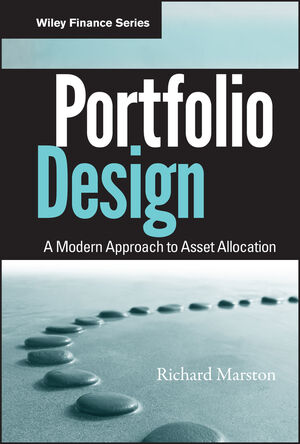|
Textbook
Portfolio Design: A Modern Approach to Asset AllocationISBN: 978-0-470-93123-3
Hardcover
368 pages
March 2011, ©2011
 |
||||||
Preface xiii
Acknowledgements xv
About the Author xvii
About the Book xix
Disclaimers xxi
CHAPTER 1 Asset Allocation 1
Ingredients of Asset Allocation 3
Lessons of the Recent Downturn 6
So Are Bonds the Place to Invest? 10
So What Happens When the Economy Turns Up? 13
Some Necessary Tools for Analysis 15
Appendix: Description of the Statistical Tools 16
CHAPTER 2 Long-Run Returns on Stocks and Bonds 21
Stocks and Bonds Since 1951 22
How Much More Attractive Are Stocks than Bonds? 24
Real Returns 25
Reconsidering Bond Returns 27
Reconsidering Stock Returns 30
Alternative Estimates of Long-Run Stock Returns 32
Upper and Lower Bounds for Equity Returns 35
Appendix: Alternative Estimates of Stock Returns 36
CHAPTER 3 Small-Cap Stocks 41
What Do We Mean by Small-Cap Stocks? 43
Relative Performance of Large-Cap and Small-Cap Stocks—Russell Series 45
Relative Performance of Large-Cap and Small-Cap Stocks—SBBI Series 48
Relative Performance of Large-Cap and Small-Cap Stocks—Broader Analysis 50
Large-Cap and Small-Cap Stocks in a Portfolio Context 52
Summary—Key Features of Small-Cap Stocks 55
CHAPTER 4 Value and Growth Investing 57
Description of the Russell 1000 Indexes 57
Relative Performance of Growth and Value Indexes 59
Value and Growth Indexes for Earlier Periods 64
Relative Performance of Small-Cap Growth and Value Stocks 65
Portfolios with Growth and Value 69
Summary—Key Features of Growth and Value Stocks 71
CHAPTER 5 Foreign Stocks 73
Returns on Foreign and U.S. Stocks 75
Currency Capital Gains and Foreign Stock Returns 79
Diversification Benefits of Foreign Stock Investing 85
Are There Shortcuts to Owning Foreign Stocks? 90
Summary—Key Features of Foreign Stocks 93
CHAPTER 6 Emerging Markets 97
What Is An Emerging Market? 98
Emerging Stock Market Indexes 101
Emerging Stock Market Returns 103
Risks of Investing in Emerging Stock Markets 107
Emerging Market Bonds—A Brief History 113
Returns on Emerging Market Bonds 114
Summary—Key Features of Emerging Market Stocks and Bonds 117
CHAPTER 7 Bonds 121
Treasury Bonds 122
The Wider U.S. Bond Market 127
Returns on U.S. Bonds 131
Bond Markets Outside the United States 133
Summary—Key Features of Bonds 140
CHAPTER 8 Strategic Asset Allocation 143
Expanding the Portfolio to Include Other Bonds and Stocks 145
Expanding the Portfolio to Include Foreign Stocks 147
The Dirty Secret of Optimization 150
Alternative Approaches to Optimization 154
Estimating Portfolio Returns—the Premium Method 155
Portfolios in Practice—Example of MarketWatch.com’s Lazy Portfolios 159
Beyond the Traditional Efficient Frontier 163
CHAPTER 9 Hedge Funds 167
Investment Strategies 169
Hedge Fund Returns 172
Hedge Fund Biases 178
Performance Across Managers 181
Fund of Funds 182
Hedge Funds in a Portfolio 186
Summary—Key Features of Hedge Funds 187
CHAPTER 10 Venture Capital and Private Equity 191
Common Features of Venture Capital and Buyout Funds 192
Venture Capital 195
Returns on Venture Capital 198
Buyout Funds 205
Returns on Buyout Funds 207
Key Features of Private Equity 211
CHAPTER 11 Real Assets—Real Estate 213
Real Estate Investment Trusts 214
Direct Ownership of Real Estate 220
Home Ownership 223
Concluding Remarks 231
CHAPTER 12 Real Assets—Commodities 235
Sources of Return on Commodity Futures 236
Returns on Commodity Futures 239
Performance in a Portfolio 245
Does Gold Belong in the Portfolio? 249
Active Investment in Commodities—Managed Futures 251
Summary—Key Features of Commodity Investments 253
CHAPTER 13 Asset Allocation with Alternative Investments 257
Diversifying into Real Estate—Alternatives for Ordinary Investors 258
Expanding the Menu of Alternative Assets 262
High Net Worth (HNW) Portfolios 264
Ultra HNW Portfolios 266
Lessons about Alternatives from the Yale Endowment 269
Lessons about Alternative Investments Learned in the Financial Crisis 277
Verdict on Alternative Investments 280
CHAPTER 14 Investing and Spending by Foundations 285
Spending Rules 286
Estimating Future Bond and Stock Returns 288
Volatility and Uncertainty 288
Portfolios of Stocks and Bonds 290
Description of the Spending Plan 291
Using Historical Returns Since 1951 to Set Spending Rules 292
Effect of Lower Stock Returns on Spending Rules 294
Effects of Different Stock/Bond Allocations 296
Concluding Comments 299
CHAPTER 15 Investing and Spending in Retirement 303
Longevity 306
Spending Rules for Retirement 308
Portfolios of Stocks and Bonds 309
Baseline Case: Can Two Live More Cheaply Than One? 310
Effects of Bequests and Variable Spending Rules 311
How Can I Turn a Defined Contribution Plan into a Defined Benefit Plan? 313
Concluding Comments—Postpone Retirement? 314
CHAPTER 16 The Discipline of Asset Allocation—Rebalancing 319
Rebalancing Defined 320
Rebalancing When Times Are Good 321
Rebalancing When Times Are Bad 323
References 325
Index 331



